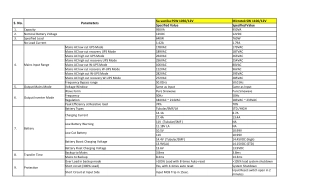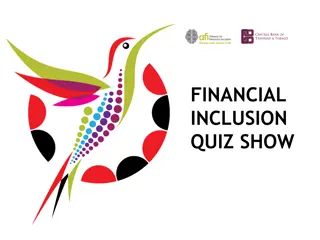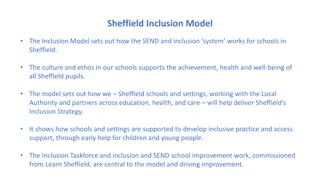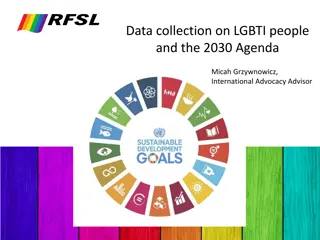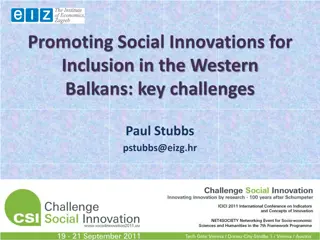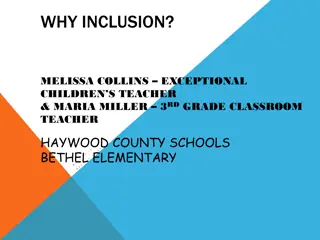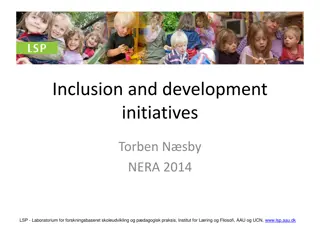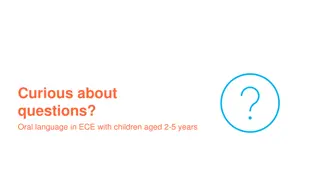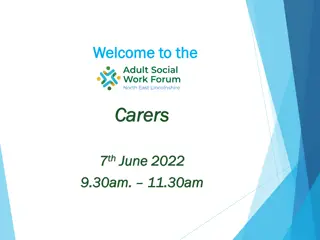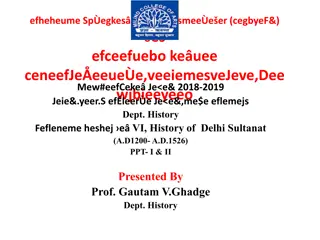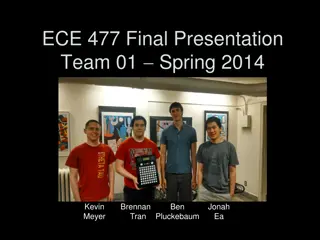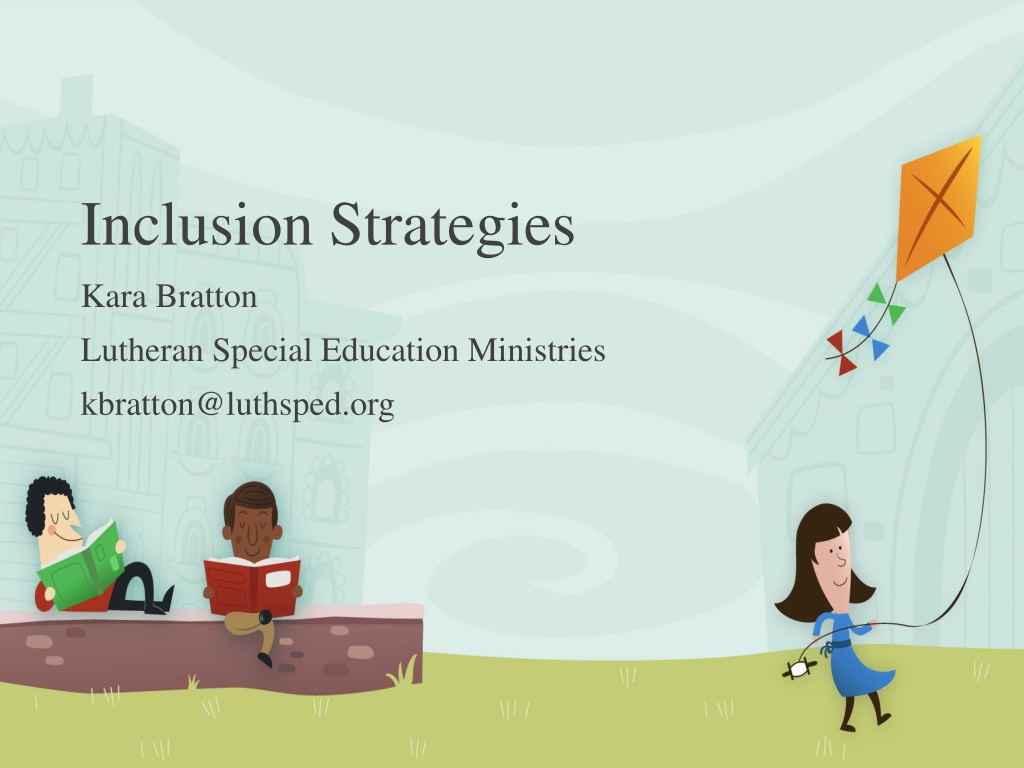
Effective Inclusion and Reading Strategies for Special Education
Explore inclusive practices and reading strategies for special education students, including finger tapping for spelling, syllabification, and auditory practice. Delve into math strategies such as subitizing to enhance number recognition skills. Access valuable resources and tools to support diverse learning needs in a comprehensive manner.
Download Presentation

Please find below an Image/Link to download the presentation.
The content on the website is provided AS IS for your information and personal use only. It may not be sold, licensed, or shared on other websites without obtaining consent from the author. Download presentation by click this link. If you encounter any issues during the download, it is possible that the publisher has removed the file from their server.
E N D
Presentation Transcript
Inclusion Strategies Kara Bratton Lutheran Special Education Ministries kbratton@luthsped.org
Reading Simulation When you see: Pronounce as: q d or t z m p b b p ys er a, as in bat e, as in pet e, as in pet a, as in bat http://www.pbs.org/wgbh/misunderstoodminds/experiences/readexp1a.html
Reading Simulation Passage: We pegin our qrib eq a faziliar blace, a poqy like yours enq zine. Iq conqains a hunqraq qrillion calls qheq work qogaqhys py qasign. Enq wiqhin each one of qhese zany calls, each one qheq hes QNA, Qhe QNA coqe is axecqly qhe saze, a zess-broquceq rasuze. So qhe coqe in each call is iqanqical, a razarkaple puq veliq claiz. Qhis zeans qheq qhe calls are nearly alike, puq noq axecqly qhe saze. Qake, for insqence, qhe calls of qhe inqasqines; qheq qhey're viqal is cysqainly blain. Now qhink apouq qhe way you woulq qhink if qhose calls wyse qhe calls in your prain.
Reading Simulation Here is the translation: We begin our trip at a familiar place, a body like yours and mine. It contains a hundred trillion cells that work together by design. And within each one of these many cells, each one that has DNA, The DNA code is exactly the same, a mass-produced resume. So the code in each cell is identical, a remarkable but valid claim. This means that the cells are nearly alike, but not exactly the same. Take, for instance, the cells of the intestines; that they're vital is certainly plain. Now think about the way you would think if those cells were the cells in your brain. (Excerpt from "Journey into DNA" on the "Cracking the Code" Web site, NOVA Online.)
Reading Strategies Finger Tapping for Spelling Sound Cards & Blending
Reading Strategies Syllabification The Fantastic Syllable Division Word Book (orton-gillingham.com) Red words/Non-phonetic words
Reading Strategies Auditory Practice
Math Strategies Subitizing Subitizing is the ability to recognize the number of briefly presented items without actually counting. https://www.youtube.com/watch?v=nLsIrNXxZ Wo
Math Strategies (from Bob Sornson) Subitizing Use a game spinner and place different numbers of stickers in each section (start small and build up accordingly) Have children spin spinner and quickly say how many stickers there are without counting Swatting Flies Attach velcro to a fly swatter and have a pile of 10-12 little black pompoms(flies) on the table Child swats the table and quickly identifies how many he or she struck, without counting
Math Strategies (from Bob Sornson) One-to-one correspondence (start with single digit numbers before moving on to double digits) Have number line on floor, stepping stones, with dots, not number symbols (tape, chalk if outside, on paper plates, etc) Ask child to take steps forward, counting as he/she goes, connecting word to number of dots Go back to start and ask child to take x number of steps forward, back to start, repeat with different number Goal is for child to feel the difference between numbers, not associate with written number symbol, building number sense Move stepping stones to varying distances apart or make it so child has to cross midline
Math Strategies (from Bob Sornson) One-to-one correspondence Ask child to catch x number of beanbags Child counts while catching and stops at appropriate number Variation: Have child hold all beanbags until appropriate number is caught so the difference in weight is sensed between catching 2 beanbags and 6 beanbags Variation: Have child stand on a balance board while catching, helps improve attention and skill retention through vestibular stimulation
Math Strategies (from Bob Sornson) Understanding Combinations Establish a target for throwing (hula hoop, box, etc) Ask the child to pick up x number of beanbags (or other object) and throw them into the target Once all objects are thrown, ask child to identify how many are in the target and how many are not Allow child to make connection that the two numbers combine to make original number on their own
Math Strategies (from Bob Sornson) Understanding Combinations Use the previously mentioned numberline with dots, no number symbols Ask the child to move to a certain number on the number line Once there, ask the child how many more steps it will take to get to number x Let him or her look at the numbers, think, and answer before prompting to take the steps (while counting) and see if he or she was correct Variation: As child develops number sense, do this activity with number symbols rather than dots or zippers for number lines
Math Strategies (from Bob Sornson) Understanding Combinations Use same numberline again Ask child to take x steps forward then x steps backward and have child say where he or she is now Variation: Use number symbols rather than dots as child progresses
Reading and Math Resources Florida Center for Reading Research Student Center Activities: Reading http://www.fcrr.org/for-educators/sca.asp National Council of Teachers of Mathematics: Focal Points Activities http://illuminations.nctm.org/Default.aspx Reading Rockets http://www.readingrockets.org/guides/other http://www.readingrockets.org/guides/readingrockets http://www.intensiveintervention.org/sample-lessons-activities http://www.doe.virginia.gov/instruction/mathematics/elementary/number_sense_module/nns_modules_2012.pdf Get Ready to Read Games: http://www.getreadytoread.org/skill-building-activities/online-games Skill Building Activities: http://www.getreadytoread.org/skill-building-activities Starfall: http://more.starfall.com/m/welcome/index/load.htm
Reading and Math Resources Bob Sornson Early Learning Foundation http://earlylearningfoundation.com/publications/ Essential Skill Inventories The Math MOMS & DADs Home Program Essential Math Skills Hawthorne Intervention Manuals- https://www.hawthorne- ed.com/pages/home%20page/interventionmanuals. html
Other Strategies Less is more with verbal instruction; even highly verbal students may experience anxiety from too much verbal instruction Provide highly structured and predictable routines and procedures Prepare for new routines and places Transitions Transition Objects Carry object to next activity or photograph Specific cue and routine for certain students Spot marked on rug for circle time, child allowed to go first and sit before others
Other Strategies Prepare for transitions Not just verbally, but visually Well in advance of transition and more than once Visual Timers Time Timers https://www.timetimer.com/collections/all Visual Countdown
Strategies- Visual Schedules Great for all younger students, including those with autism and cognitive impairments These children may have trouble with sequential processing, but do better with visual processing Visual schedules allow children to be more flexible and adaptable (something children with autism struggle with) Schedule gives children stability and routine, even if activities change from day to day Teach children how to read and use visual schedules Could have one for whole class and/or for individual children as needed Autismschedules.com
Strategies- Visual Schedules First, Next Then 3 activities pictured; second activity least desirable Verbally review activities with child After each task is complete, child removes picture and places in stop pocket Schedule can be reset after all pictures are in stop pocket
Strategies- Visual Schedules Schedule Board with stop pocket Can have the whole day of activities or just a few on strip After each activity is completed, remove task and put in stop pocket Ghostbusters symbol
Other Strategies Choice Boards Displays a limited number of choices for activities Children with autism often have difficulty figuring out what to do next or choosing from unlimited options
Other Strategies Students who need additional time to process sensory input get very fatigued. Remember that they are processing much information at a much higher threshold than their peers (a pencil dropping is processed with the same level of intensity as the teacher's voice, with the students often having difficulty discerning what sensory information is the most important). Plan the intensity of their days accordingly. Make sure the student knows how to ask for a break. Use a visual support if necessary. Define acceptable break options for the student and allow them to choose. Remember that if the student has to come back and finish the non-preferred task, then he is not successfully avoiding the task. Use sensory items (velcro, fabric books, box with pillows, weighted vests and blankets) https://www.nationalautismresources.com/sensory-ot/ https://www.therapyshoppe.com
Other Strategies Use cards to reduce behaviors Example: student talks during class; monitor how many times/day this happens and give student less cards to begin; every time behavior happens, student has to give teacher a card; student will learn he/she can not do that once out of cards; over time cards are reduced; provide reinforcement as appropriate
Talking to Parents Talk with parents regularly about the child, not only when you notice a difficulty Start with the child s strengths Have documentation ready, and copies available for parents Discuss behaviors/academic concerns you see in the classroom Listen to their concerns and observations Do not make or suggest a diagnosis yourself Encourage the parent to talk to appropriate doctor for evaluation Follow up after a few weeks https://www.cdc.gov/ncbddd/actearly/pdf/parents_pdfs/TipsTalkingParents.pdf
Talking to Parents When parents disagree Avoid becoming defensive, but state that you are describing and documenting what you see; ask parent how this seems different from what they see at home When parents become upset or angry Reinforce the idea that you are trying to help their child as best as you possibly can Ask if they would like to think about what you said on their own and meet again at a different time If you believe meeting or followup may be contentious, ask a director or other teacher to attend the meeting as well
Stay in Touch! Luthsped.org Sign up for our free e-newsletters Always available for FREE consultations Available for professional development for schools and churches

